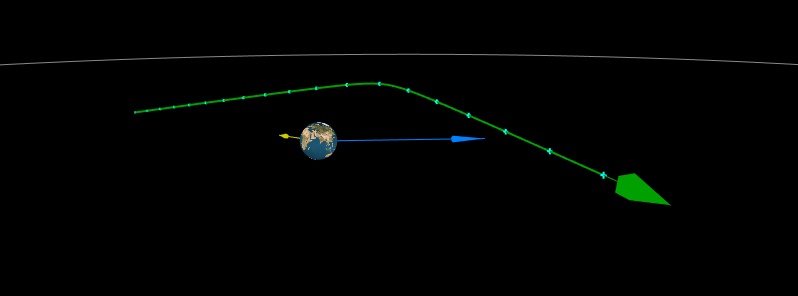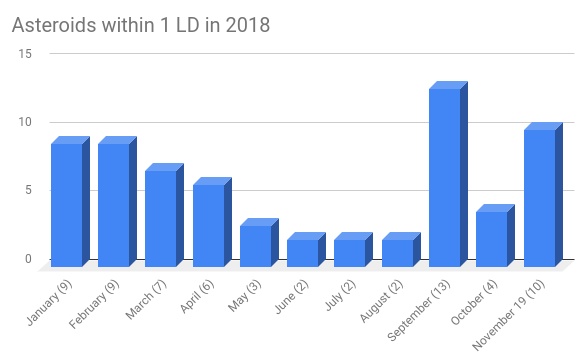4 newly detected asteroids within 1 lunar distance, including second closest of the year

Four new <1 LD Apollo-class asteroids were detected at Catalina and Mt. Lemmon sky surveys on November 17, 2018. Three of them, including the second closest of the year, flew past our planet on November 16 and 18 while the fourth is expected at 23:23 UTC today, November 19. The total number of known <1LD asteroids this year now stands at 66.
Asteroid 2018 WH
Asteroid 2018 WH was first observed at Catalina Sky Survey, near Tucson, Arizona on November 17. Its estimated diameter is between 2.8 and 6.3 m (9 – 20 feet).
The object made its closest approach to Earth at 05:49 UTC on November 16 at a distance of 0.50 LD / 0.00128 AU (191 485 km / 118 983 miles) and a speed (relative to the Earth) of 7.81 km/s.
[ Ephemeris | Orbit Diagram | Orbital Elements | Mission Design | Physical Parameters | Close-Approach Data ]
Reference
2018 WH at Minor Planet Center; at CNEOS
Asteroid 2018 WG (second closest of the year)
Asteroid 2018 WG was also first observed at Catalina Sky Survey on November 17, making it the second <1 LD asteroid discovery of the day.
This object has an estimated diameter between 3.7 and 6.3 m (12 and 20 feet) and it flew past us at a very close distance of 0.08 LD / 0.00021 AU (31 415 km / 19 520 miles) at 19:14 UTC on November 16.
This makes it the second closest known asteroid to flyby Earth this year and the third closest over the past 12 months. The two others are 2018 DN4 on October 19, 2018 (0.04 LD / 9.14e-5 AU) and 2017 WE30 on November 26, 2017 (0.08 LD / 0.00020 AU).
[ Ephemeris | Orbit Diagram | Orbital Elements | Mission Design | Physical Parameters | Close-Approach Data ]
Reference
2018 WG at Minor Planet Center; at CNEOS
Asteroid 2018 WE
2018 WE was first observed at Mt. Lemmon Survey on November 17. This asteroid has an estimated diameter between 5.6 and 13 m (18.3 and 42 feet).
It flew past us at 0.62 LD / 0.00160 AU (239 356 km / 148 729 miles) at 13:55 UTC on November 18 at a speed (relative to the Earth) of 12.8 km/s.
[ Ephemeris | Orbit Diagram | Orbital Elements | Mission Design | Physical Parameters | Close-Approach Data ]
Reference
2018 WE at Minor Planet Center; at CNEOS
Asteroid 2018 WJ
Asteroid 2018 WJ will flyby Earth at 23:23 UTC on November 19 at a distance of 0.31 LD / 0.00079 AU (118 182 km / 73 435 miles) and a speed (relative to the Earth) of 18.65 km/s.
This asteroid has an estimated diameter between 7.7 and 17 m (25 and 55 feet). It was first observed at Mt. Lemmon Survey on November 17.
[ Ephemeris | Orbit Diagram | Orbital Elements | Mission Design | Physical Parameters | Close-Approach Data ]
Reference
2018 WJ at Minor Planet Center; at CNEOS


Image credit: TW. Valid 15:15 UTC, November 19, 2018
Featured image: Asteroid 2018 WG orbit diagram. The green line indicates the object's apparent motion relative to the Earth, and the bright green marks are the object's location at approximately half hour intervals. The Moon's orbit is grey. The blue arrow points in the direction of Earth's motion and the yellow arrow points toward the Sun. Credit: Minor Planet Center

Commenting rules and guidelines
We value the thoughts and opinions of our readers and welcome healthy discussions on our website. In order to maintain a respectful and positive community, we ask that all commenters follow these rules.